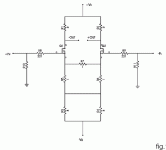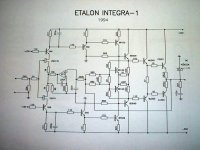lumanauw said:If you are still in feedback world, which do you prefer? Error correction or parrareled output?
I am sorry, I cannot help you as I do not like the sound of amplifiers with feedback.
lumanauw said:If I built audio power amp with Open loop gain 30X (by adjusting RC-RE for each transistor), but I put feedback so that closed loop mathematically tobe 100X, what happens?
The gain will be reduced slightly, as you are adding a small amount of feedback.
lumanauw said:Will the amp still works in 30X gain, but it can hold DC offset like ordinary feedback amp?
No, you don't understand how a conventional amplifier works. In a conventional amplifier, the feedback network applies 100% feedback at DC. This is what makes it "hold DC offset". Please read more on op-amps and you will understand what I mean.
lumanauw said:Will this considered to be non-feedback amp, because closed loop is larger than open loop gain?
No, there will still be feedback. You can measure the gain reduction by adding the feedback. If the gain is reduced (for example) by 2 dB, then the amplifier has 2 dB of negative feedback. This would be a low-feedback design but not a zero feedback design.
Normally I would consider low feedback to be less than 20 dB. Other people have different opinions. For example I think Douglas Self calls his amps "low feedback" or maybe "moderate feedback", and he has 40 dB at 20 kHz (more at lower frequencies).
Charles Hansen said:No, you don't understand how a conventional amplifier works. In a conventional amplifier, the feedback network applies 100% feedback at DC. This is what makes it "hold DC offset". Please read more on op-amps and you will understand what I mean.
This would be a generalization. Many amplifiers do not run
at unity gain at DC, and the amount of feedback applied would
not be 100%.
The issue of whether or not it is actually possible to have a
non-feedback amp will raise its head here at some point.
I take non-feedback to mean that there is no effort to have a
feedback loop at audio frequencies.
Nelson Pass said:This would be a generalization. Many amplifiers do not run
at unity gain at DC, and the amount of feedback applied would
not be 100%.
You are correct, I was generalizing. Except for your products and mine, probably 99% of all commercially available audio amplifiers use either 100% DC feedback or else a DC servo that has more than 100% feedback. In any event, I think that the poster's question would be well answered in any book that discusses operational amplifiers.
Nelson Pass said:The issue of whether or not it is actually possible to have a
non-feedback amp will raise its head here at some point.
I would have to assume that is because some people like to argue about semantics.
Nelson Pass said:I take non-feedback to mean that there is no effort to have a
feedback loop at audio frequencies.
Nelson, how can I argue with you if you persist in being so darned reasonable?
Charles Hansen said:I would have to assume that is because some people like to argue about semantics.
Yes. Because semantics includes:
b : the language used (as in advertising or political propaganda) to achieve a desired effect on an audience
I've found that those who dismiss arguments as "semantics" are often in the business of selling something.
se
Charles
You are so fanatic about non feedback amp. In some design, like Stevens, LC audio, Etalon, they always use complementary differential.
This is my question. Why I never saw non-feedback amp with single differential. Is it impossible to make non-feedback amp with only single differential?
Does non-feedback design without any servo have good DC offset towards heat behavior?
You are so fanatic about non feedback amp. In some design, like Stevens, LC audio, Etalon, they always use complementary differential.
This is my question. Why I never saw non-feedback amp with single differential. Is it impossible to make non-feedback amp with only single differential?
Does non-feedback design without any servo have good DC offset towards heat behavior?
First of all, I do not consider an amp with error correction (like Steven's design posted on another thread) to be "non feedback". The LC Audio amp is "non feedback" for audio frequencies, but has a DC servo that will add some feedback at very low frequencies. I am not familliar with the Etalon circuit.
It is very easy to make a "non feedback" amp with single differential. My personal preference is for complementary circuits, so that is what I make.
All of the Ayre power amps and line stages are true DC amplifiers with no audio feedback, no DC feedback, no servo, and no coupling capacitors. You can make them with good DC behavior, but you must be very careful and pay close attention to many details. The best information on doing this was in an article by Erno Borbely in Audio Amateur magazine about 20 years ago. He had a design called "DC-100" and he detailed many of the factors that must be considered. Perhaps it is available on his website, I don't know.
It is very easy to make a "non feedback" amp with single differential. My personal preference is for complementary circuits, so that is what I make.
All of the Ayre power amps and line stages are true DC amplifiers with no audio feedback, no DC feedback, no servo, and no coupling capacitors. You can make them with good DC behavior, but you must be very careful and pay close attention to many details. The best information on doing this was in an article by Erno Borbely in Audio Amateur magazine about 20 years ago. He had a design called "DC-100" and he detailed many of the factors that must be considered. Perhaps it is available on his website, I don't know.
I never heard a non-feedback amp. Quasi feedback, yes. Bass behavior (tight or not) usually depends on feedback factor. Bigger feedback will give more control of bass. Can non feedback gives tight bass?
Also non feedback amp usually have very big RE or RS(FET), like LC uses 1k5, Steven uses 2K7.
RE in Doug Self book is needed to drop about 60mV. Too much of this will gives lack of detail/transparency (my personal opinion). Like Leach, he uses up to 300ohm, the issue is to advoid TIM.
But the most detailed/transparent sound comes from RE=0 (tied emitors in the differential together without any re. This is also my personal opinion). PRR once said that slight TIM is good, if not too much. Pass seldom uses RE at all.
So what is the sound of non feedback amp? How is the frequency response curve, can be flat without heavy bias in every stage?
Sorry, Charles, so many question. I just not familiar with non-feedback.
ps. Can you attach example of non feedback with single differential?
Also non feedback amp usually have very big RE or RS(FET), like LC uses 1k5, Steven uses 2K7.
RE in Doug Self book is needed to drop about 60mV. Too much of this will gives lack of detail/transparency (my personal opinion). Like Leach, he uses up to 300ohm, the issue is to advoid TIM.
But the most detailed/transparent sound comes from RE=0 (tied emitors in the differential together without any re. This is also my personal opinion). PRR once said that slight TIM is good, if not too much. Pass seldom uses RE at all.
So what is the sound of non feedback amp? How is the frequency response curve, can be flat without heavy bias in every stage?
Sorry, Charles, so many question. I just not familiar with non-feedback.
ps. Can you attach example of non feedback with single differential?
lumanauw said:ps. Can you attach example of non feedback with single differential?
Son of Zen
R7 is a source coupling resitor of the differential MOSFET pair. Regarding its value, R1 and R2 values and the gm of MOSFETs the voltage gain is estimated. The higher the R7, the lower the gain and distortion. R7 creates voltage feedback in the same way as for single transistor it is created by emitter resistor.
Nelson Pass said:Since any device's limited transconductance is the same
as Source resistance, you are saying that there is no such
thing as non feedback. I disagree, for reasons previously
outlined.
Maybe not exactly. There is always intrinsic Ree etc. that creates feedback.
Son of Zen
Very Pass indeed. Simple but thats it!. Never tought the answer is like that. I have it for a long time. And its correct.
Does anyone have more complex example, like 3 stages with non feedback? I wanted to see how DC can be controlled with only single differential.
Charles, this is ETALON. What do you think of this? I have difficulties in calculating bias in first and second stage. How can I calculate bias with such a "self-biasing" stacking Fet pairs?
Attachments
lumanauw said:How can I calculate bias with such a "self-biasing" stacking Fet pairs?
The exact bias will vary depending on the Idss of each FET in the pair. However, it is easy to make a rough estimate, which is all that is needed. Download the data sheet from the Toshiba Japan website. Then look at the curves of Vgs versus Id. Draw a load line of 36 ohms starting from the origin of 0,0 up with a slope of 36 volts per amp.
There will be several curves. Assuming you are using the BL devices, the Idss will be around 8 mA, so use that curve. Where the load line intersects the curve is the operating point.
Charles Hansen said:I disagree that R7 introduces any feedback. Please explain your reasoning.
It reduces voltage across the transistor according to changes of the output voltage. Just voltage feedback - reducing gain and distortion. Same principle as for opamps, only the opamp triangle symbol is not apparent.
- Status
- This old topic is closed. If you want to reopen this topic, contact a moderator using the "Report Post" button.
- Home
- Amplifiers
- Solid State
- Charles Hansen come in please

